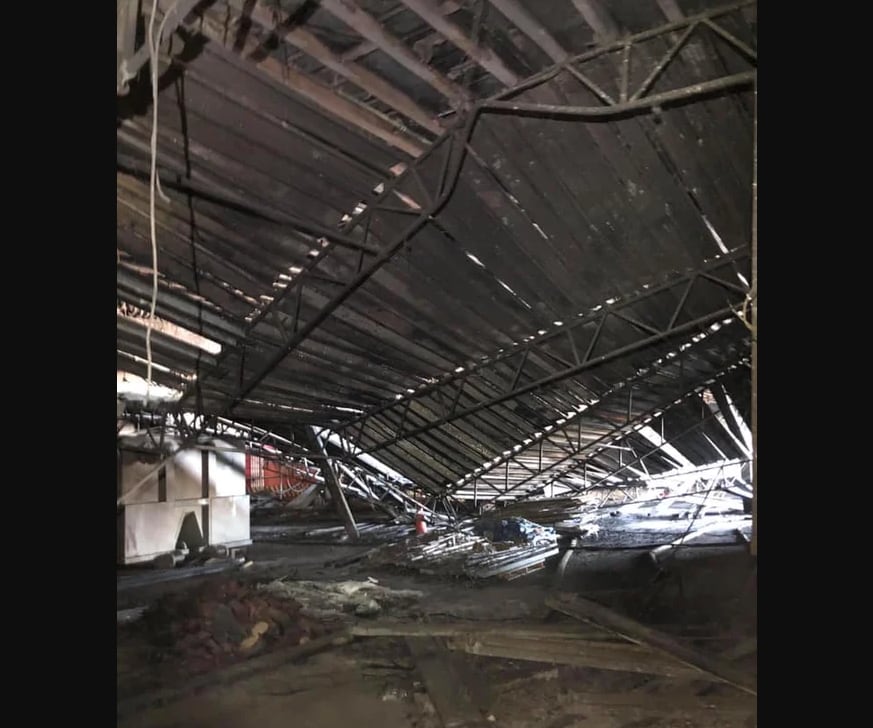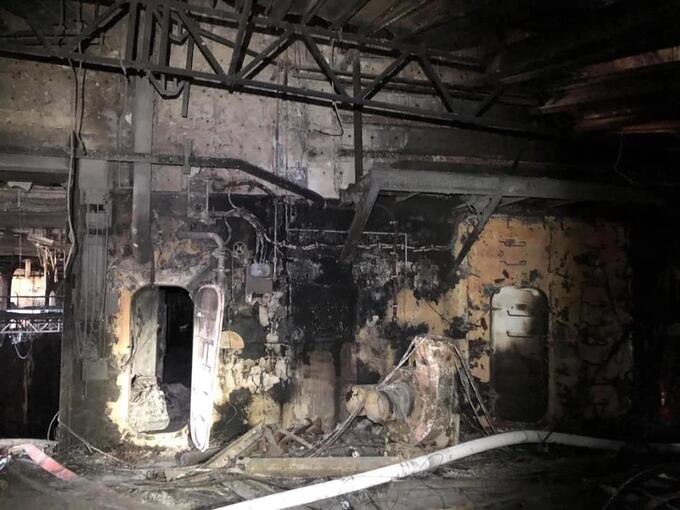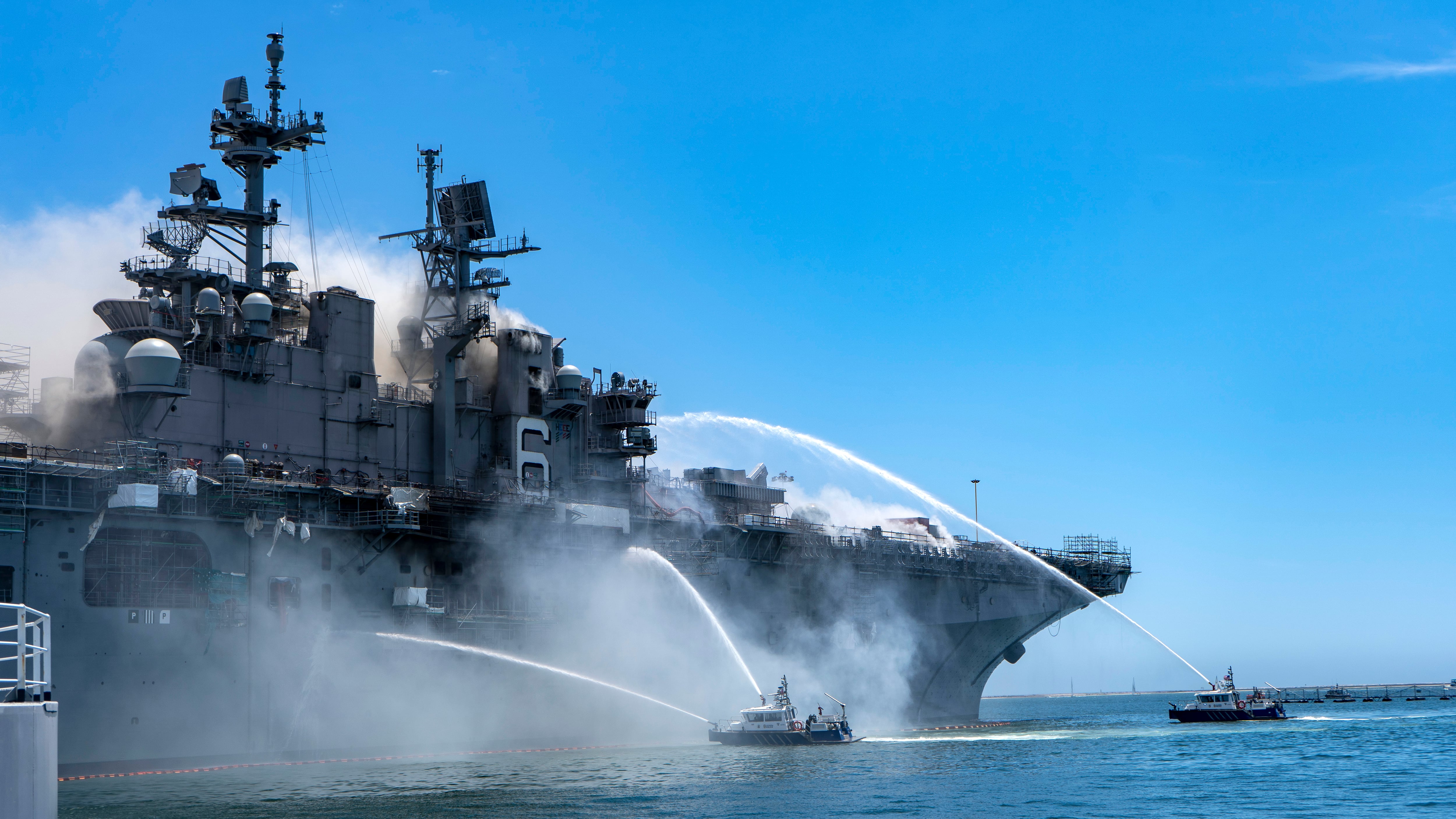Fire crews thought they might be able to get the fire aboard the amphibious assault ship Bonhomme Richard under control Sunday night after it had been burning throughout the day, but wind and explosions forced leadership to pull fire crews back in the name of safety, Chief of Naval Operations Adm. Mike Gilday said Friday at a press conference near the amphib in San Diego.
Instead, the fire engulfed the ship from fore to aft, and it burned for more than four days before the Navy announced the extinguishing of all fires Thursday.
“We really thought we had this fire under control, had the potential to have the fire under control, as early as Sunday night,” Gilday said.
Noting that the Navy had not seen a ship fire of this magnitude in his decades-long career, Gilday said wind off the bay and the spot where the fire was first called away at 8:30 a.m. Sunday helped it spread and hindered efforts to put it out.
“This fire couldn’t have been in a worse point on the ship,” Gilday said during the 20-minute press conference. “A lot of it spread up elevator shafts … up exhaust stacks … to take the fire up into the superstructure and forward.”

“A series of explosions” on the ship also forced the ship’s commanding officer, Capt. Gregory Thoroman, to pull back firefighters in the name of safety, which was the right call, Gilday said.
“I’m told one in particular could be heard 13 miles away,” CNO said.
One explosion blasted debris onto another ship across the way, he added.
“There are times he had to back those firefighters off the ship,” Gilday said. “The situation was very tenuous; the commanding officer made some very sound decisions on how to attack the fire very deliberately.”
Gilday also praised the hundreds of sailors from across the San Diego waterfront who entered the burning ship repeatedly to fight the fire.
“An environment where you could only see two feet in front of you,” he said, citing the bravery of the fire crews, who had an average age in their early 20s. “To go into that environment again and again and again, temperatures at some point in excess of 1,000 degrees.”
Dozens of Navy and civilian firefighters were treated for heat exhaustion and smoke inhalation.
“If anybody has any doubts about this generation of sailors, soldiers, airmen or Marines … it should be put to rest,” Gilday said.
The CNO laid out at least four investigative paths going forward.
A safety investigation, which kicks off with any such shipboard mishap, will be spearheaded by Naval Sea Systems Command.

The Naval Criminal Investigative Service will also probe the incident “as we always do, to make sure there’s no malfeasance at the root of the fire,” Gilday said.
A command investigation will look at procedures before and reactions to the fire up and down the command echelon, he said.
“We will follow the facts,” he said, promising that investigations into the fire will be made public. “We’ll be honest with ourselves.”
Four-star fleet commanders have directed every ship in the Navy to ensure that all equipment is ready and that sailors are trained up on procedures for such situations, “so we can all learn from this tragedy,” Gilday said.
A fourth assessment will look at the structural, electrical and mechanical damage, bringing in industry experts, ship designers and others who will determine whether repairs are feasible or not.
Gilday suggested that getting the Bonhomme Richard back out to sea might not be worth the money.
“I know everybody is interested in the future service of this ship,” he said. “I am 100 percent confident our defense industry can put this ship back to sea. The question is should we make that investment into a 22-year-old ship.”
The Bonhomme Richard was in the shipyard and in the midst of extensive upgrades so that it could accommodate the next-generation F-35B fighter jet.
That meant tons of contractor materials laid about throughout the ship, and thick bundles of cables snaking through hatches.
Gilday said mitigation plans are in place for every ship in some situations, including quick disconnects for some hatches.
RELATED

Crews also practice fire and flooding drills regularly, so why Bonhomme Richard burned so ferociously for more than four days remains unclear.
“As good as you think you are, you’re never as good as you think you are,” Gilday said.
The Navy is also going to review the sizes of its duty sections, and “whether or not we had an adequate number of people on board,” he said.
He called the burning of the ship “a gut punch” for its crew, but said they are being looked after.
“The names of those ships mean something to those sailors,” Gilday said. “This is their home. This is where they would fight from.”
Geoff is the managing editor of Military Times, but he still loves writing stories. He covered Iraq and Afghanistan extensively and was a reporter at the Chicago Tribune. He welcomes any and all kinds of tips at geoffz@militarytimes.com.



